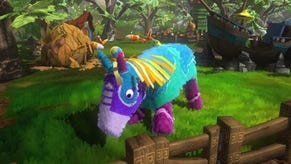Viva Piñata: Pocket Paradise
Filled with fun. And a new interface.
You won't catch anyone at Rare calling it a homecoming. Or a departure, for that matter. Even though Rare's remote Twycross base of operations, nestled deep in the gentle folds of the Warwickshire countryside, is dripping with memorabilia of its days as a Nintendo-owned first-party developer, none of its down-to-earth staff harp on about the old days.
By the same token, Microsoft may have bought this particular farm - and we may be drinking water out of Xbox-branded bottles - but Rare's initial presentation of Viva Piñata: Pocket Paradise for DS doesn't even mention the 360 original at all. Judging by the tone, this is just Rare's handheld division plugging away at developing another handheld version of a classic Rare franchise for THQ. It might as well be Sabreman.
But it is more significant than that, and it is a homecoming. Not because of the Nintendo connection necessarily, but because Viva Piñata was always supposed to fit in the palm of your hand - and because it arguably makes more sense when it does.
DS owners joining us without the benefit of the 360 or PC's context will wonder what the fuss is about. The fuss is about building a garden paradise, gradually coaxing cuddly new animals into it and convincing them to stay by landscaping and nurturing the environment to fit their needs.
Lost among fat-necked-men-shooting-aliens at the back end of 2006, the Xbox 360 original still found a loving and devoted audience, reinforced by PC gamers a while later, and the only thing they had to overcome was a quirky interface: a picket hurdle the DS version sets out to eliminate.

Viva Piñata was originally kicked around Rare's offices as an idea for a handheld game, and the absorbing, nurturing, slower-paced gameplay and compulsive collection and trading certainly fit that bill - as does the younger demographic, catered for by the 4kids cartoon. But it's the DS in particular that suits the game down to the ground. Touch control and the dual-screen layout make the creative and managerial aspects of Viva Piñata an instinctive, tactile breeze.
Your garden occupies the touch-screen, and is about four screens by four in size. You can push the camera around by drawing the stylus to the edges of the screen, tapping on a d-pad symbol in the bottom-right corner, or using the d-pad itself. Moving piñata around is a matter of tapping on them to select and then dragging to where you want them to go, or tapping on the item or piñata you want them to interact with. You can only do this with resident piñata, naturally; those wandering around outside will only join you when your garden fits their needs.
Tools and shopping items are selected with quick taps on an expanding menu system in the top right corner, and used directly with the stylus; grass and ponds can be drawn in, sleeping piñata nudged with a spade handle, apples, carrots, seeds and fallen flower petals picked up and dragged to new locations.
An overview map of the entire garden can be called up at any point showing the locations of all resident and non-resident piñata, although the latter appear as a mystery paw-print only, and a double-tap on any part of it (or any creature) centres the camera there. Double-tapping on the regular view zooms the camera in further and allows you to stroke piñata to improve their happiness.




